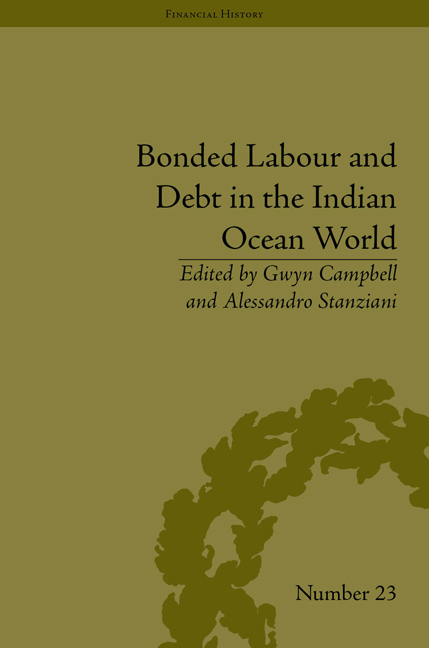Book contents
- Frontmatter
- Contents
- Acknowledgements
- List of Contributors
- Introduction
- 1 Debt and the Coercion of Labour in the Islamic Legal Tradition
- 2 Debt, Pawnship and Slavery in Nineteenth-Century East Africa
- 3 Debt and Slavery in Imperial Madagascar, 1790–1861
- 4 Credit and Debt in the Lives of Freed Slaves at the Cape of Good Hope: The Case of Arnoldus Koevoet, 1697–1735
- 5 Debt, Labour and Bondage: English Servants versus Indentured Immigrants in Mauritius, from the Late Eighteenth to Early Twentieth Century
- 6 Ransom, Escape and Debt Repayment in the Sulu Zone, 1750–1898
- 7 Debt and Slavery among Arabian Gulf Pearl Divers
- 8 The Political Economy of Debt Bondage in Contemporary South India
- 9 The Name of the Slave and the Quality of the Debt: When Slaves Are Not Debtors and Debtors Are Not Slaves in the Family Narrative of a Filipina Comfort Woman
- 10 Two Bonded Labour Emigration Patterns in Mid-Nineteenth-Century Southern China: The Coolie Trade and Emigration to Southeast Asia
- 11 Debt Slaves in Old Korea
- 12 The Debt-Servitude of Prostitutes in Japan during the Edo Period, 1600–1868
- Notes
- Index
8 - The Political Economy of Debt Bondage in Contemporary South India
- Frontmatter
- Contents
- Acknowledgements
- List of Contributors
- Introduction
- 1 Debt and the Coercion of Labour in the Islamic Legal Tradition
- 2 Debt, Pawnship and Slavery in Nineteenth-Century East Africa
- 3 Debt and Slavery in Imperial Madagascar, 1790–1861
- 4 Credit and Debt in the Lives of Freed Slaves at the Cape of Good Hope: The Case of Arnoldus Koevoet, 1697–1735
- 5 Debt, Labour and Bondage: English Servants versus Indentured Immigrants in Mauritius, from the Late Eighteenth to Early Twentieth Century
- 6 Ransom, Escape and Debt Repayment in the Sulu Zone, 1750–1898
- 7 Debt and Slavery among Arabian Gulf Pearl Divers
- 8 The Political Economy of Debt Bondage in Contemporary South India
- 9 The Name of the Slave and the Quality of the Debt: When Slaves Are Not Debtors and Debtors Are Not Slaves in the Family Narrative of a Filipina Comfort Woman
- 10 Two Bonded Labour Emigration Patterns in Mid-Nineteenth-Century Southern China: The Coolie Trade and Emigration to Southeast Asia
- 11 Debt Slaves in Old Korea
- 12 The Debt-Servitude of Prostitutes in Japan during the Edo Period, 1600–1868
- Notes
- Index
Summary
Every year in the Villipuram District in the southern Indian state of Tamil Nadu, which is ranked one of the wealthiest of India, just after the mid-November Dipawali festival, entire families leave for the outskirts of Chennai to work as brick moulders. They return six months later at the start of the rainy season, with the sole goal of resting and forgetting the suffocating heat of the kilns. A few weeks later, it is the turn of cane cutters to head south. Once again, men, women and children depart for several months, returning equally exhausted by terrible working conditions. In both cases, wage advances push families to migrate and to tolerate deplorable working conditions. The luckiest are able to return with a small amount of savings. Most, however, will not have been sufficiently ‘productive’. Some return empty-handed, while others are even forced to return the following year to pay off their accrued debt. This kind of circular migrant is beyond the reach of any census, but there are hundreds of thousands of them, perhaps even millions, in the state of Tamil Nadu alone. Elsewhere in the north-west of the state, far from prying eyes, other families are confined to sheds, their entire lives revolving around drying rice, for which they work around the clock. These individuals are also initially migrants, though they are never able to return home, trapped through indebtedness to their employers.
- Type
- Chapter
- Information
- Bonded Labour and Debt in the Indian Ocean World , pp. 119 - 134Publisher: Pickering & ChattoFirst published in: 2014

